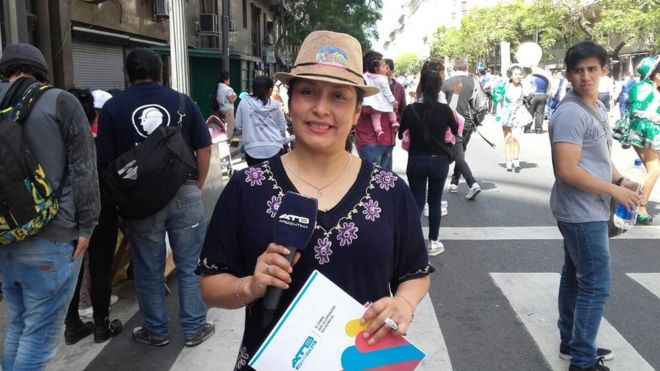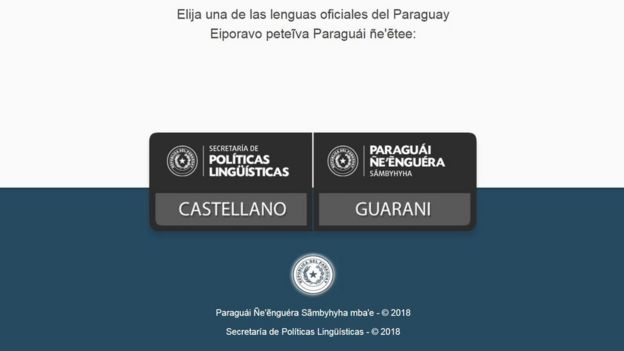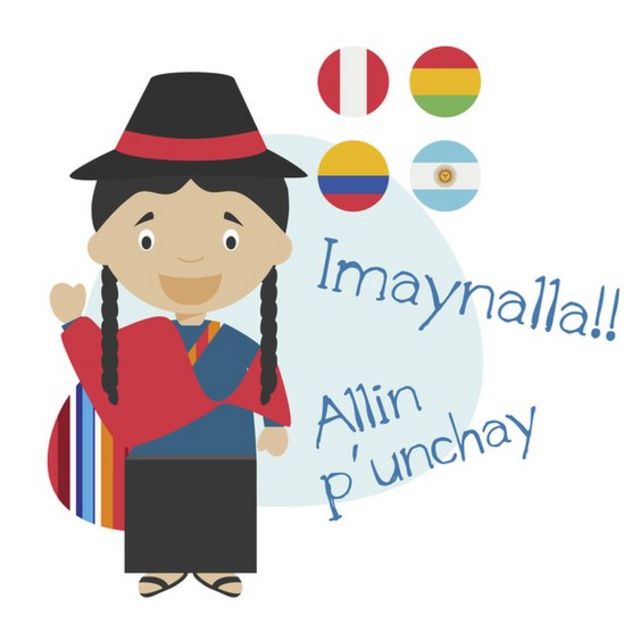How Paraguay and Bolivia managed to become bilingual countries
Marcia Carmo
From Buenos Aires to BBC News Brasil
December 29, 2018
Disc jockey Jeannette speaks Spanish and Quechua. PERSONAL ARCHIVE
Paraguay and Bolivia have established measures in recent years to ensure that indigenous languages continue to be widely spoken for generations — a strategy that helps to explain why, unlike in Brazil, mastering these languages is not something linked to minorities in these countries.
These initiatives, coupled with tradition and cultural programs in these languages, are reflected in conversations in indigenous languages among friends who travel, for example, in public transportation in Buenos Aires, where thousands of immigrants from both countries live, as well as in the public offices, in the markets and in the streets of Laz Paz, in Bolivia, and Asunción, in Paraguay.
It is common to observe how Paraguayans naturally switch from Spanish to Guarani, or vice versa, when they talk among themselves. And as a Bolivian interviewee told BBC News Brasil, bilingualism is almost a weapon to prevent the people around, who only speak Spanish, from understanding what is being said.
This method, incidentally, was used in armed conflicts between the two countries, but today, it does not always work. "Sometimes I'm on the bus here in Buenos Aires and I hear a group speaking Quechua, thinking no one is understanding them. But I understand and end up laughing alone because of it", said Jeannette Nava Flores, 42, born in Sucre, Bolivia, disc jockey at radio station Metropolitana 99.7, FM, in Spanish, and a journalist for ATP Argentina.
Original languages
In Bolivia, mainly in the Altiplano region in the West, there are radio and television programs, including children's shows, in indigenous languages and musical groups that sing the so-called
original languages. Some Bolivians brought this practice to the Argentine capital.
"When I came to Buenos Aires, I said I could speak Aymara and ended up getting a Sunday radio show in the language I learned at home and never stopped speaking", said Freddy Flores, 29, who is from La Paz, in Bolivia, and works at Constelación, 98.1, FM. He said that, as a child, his parents and grandparents read him stories in Aymara and not in Spanish, which helped him to learn the language.
'Rohayhu' means something like 'I love you' in Guarani, one of the official languages of Paraguay. GETTY IMAGES
In his show, he plays the successful ballads of groups with songs in indigenous or folkloric languages, such as Los Awatiñas, K'ala Marka and Los Kjarkas.
The Bolivian and Paraguayan constitutions state that the national language should not be limited to Spanish. In Bolivia, there are 36 recognized languages since 2009 in the Magna Carta. In Paraguay, the Constitution states that the official languages are Spanish and Guarani — it is estimated that more than 70% of the population is bilingual.
In the 2001 Census, among a population of 6.95 million, 37.8% of Bolivians over 6 years old were bilingual — totaling 2.62 million bilingual people in the Andean country.
A decade later, in the 2012 Census, with a total population of 7.8 million inhabitants, 38.2% over 6 years old declared themselves bilingual, more than 2.98 people.
Language Law
In 2010, the so-called "language law" came into force in Paraguay, which determines that indigenous languages should be used, as well as Spanish, in public service and in the Executive, Judiciary and Legislative branches of government.
In other words, the president and other authorities of the country should be able to speak in both languages when addressing the public, as said the Director of Linguistic Planning of the National Secretariat for Language Policy, Célia Godoy, in an interview with BBC News Brasil.
"Guarani is the language that gives identity to Paraguayan culture. And keeping Guarani is a meticulous and constant job", said Godoy, who holds a doctorate in education with a major in Spanish and Guarani.
The first language she learned was Guarani, the language spoken at her parents' house. After marrying and having children, she told her husband that the tradition should be preserved. "He speaks Spanish with our children, and I only speak Guarani. Today, all three, who are 8, 15 and 20 years old, are bilingual", said Godoy.
In Paraguayan government websites, you can choose to read the page in Spanish or in Guarani. REPRODUCTION
In addition to the practices at home and the requirement of Guarani teaching in schools, as determined by local norms, there is a kind of permanent vigilance for Guarani to continue to be spoken.
In an open letter addressed to President Mario Abdo Benítez, the Guarani Language Academy complained that his inauguration speech had not been made in the indigenous language, as the newspaper
Última Hora of Asunción reported last August.
In the letter, the institution, created after the language law, expressed "concern for not having heard" the president using the "ancestral language" before the Paraguayans and the foreign authorities who participated in the inauguration ceremony.
When asked by the reporter, the president's press office reported that he speaks Guarani. "It is true that criticism has emerged, but it was not a deliberate decision [of the president not to speak in the indigenous language]," they said. As a gesture in favor of the language, they said, the president determined that all the logos of the public institutions would be updated for Spanish and Guarani.
Intimidated
For a long time, according to experts and historians, Guarani was frowned upon by the upper classes. The attitude made the lower classes feel intimidated to speak the indigenous language outside their homes. "The atmosphere has been changing since the law came into force," said Godoy.
For her, writing and grammar also play a fundamental role for the preservation of indigenous languages. This year, she said, dictionaries and books have been launched that support Guarani and other ancestral languages — Paraguay has 19 indigenous languages.
This was the case, for example, of the Manjui language dictionary released this year in the country, elaborated by researcher and professor of the Autonomous University of Entre Ríos, in Argentina, Javier Carol, at the request of Paraguayan authorities.
"The important thing about the dictionary is that it means the language exists for the State. It means that the State and the society do not hide it, and this is important for the person who speaks the language", said Carol.
It is estimated that Manjui is spoken by less than 3 thousand people. But there are other languages, like the Guaná people's, spoken by only four people, as Godoy said. The four elderly women who speak the language went through workshops to preserve the culture.
Writing plays a fundamental role for the preservation of indigenous languages. GETTY IMAGES
In many cases, according to experts, it is natural for children and adolescents to prefer TV shows, fashion and culture in Spanish, whether because of integration or shame, which makes it difficult for the indigenous language to be maintained.
For Eduardo Navarro, professor of the University of São Paulo (USP), who has been researching indigenous cultures for three decades, Paraguay is "fortunate to preserve" the indigenous language, Guarani.
"Brazil lost the opportunity to be bilingual like Paraguay, which has the highest rate of bilingualism within America and achieved this through many measures", said Navarro.
He said, however, that there are "very beautiful" initiatives in Brazil, in academia and in NGOs, but not many official ones, to support indigenous languages in the country.
USP, he said, has launched grammar publications in Nheengatu, which is from the Amazon. There are about 6,000 bilingual people spread over 700 kilometers in the Rio Negro region.
"But languages only survive if, in addition to being spoken, they are written. They need to be read or their words will be replaced by Portuguese, as it has been happening. We know that to protect the language is to protect the culture. And cultures cannot die", said Navarro, who usually takes his students to do fieldwork in the indigenous communities of São Paulo.
In South America, in addition to Paraguay and Bolivia, Peru, with 144 original languages, and Ecuador, with 14, are also countries where, depending on the territory, one can hear, to a lesser or greater extent, indigenous languages being spoken.
According to official figures, about 4 million Peruvians, out of a total population of 32 million inhabitants, speak some indigenous language. On the other hand, scholars in Ecuador warn that some indigenous languages are at risk of disappearing if they do not continue to be spoken.
How Paraguay and Bolivia managed to become bilingual countries
I thought this was interesting








